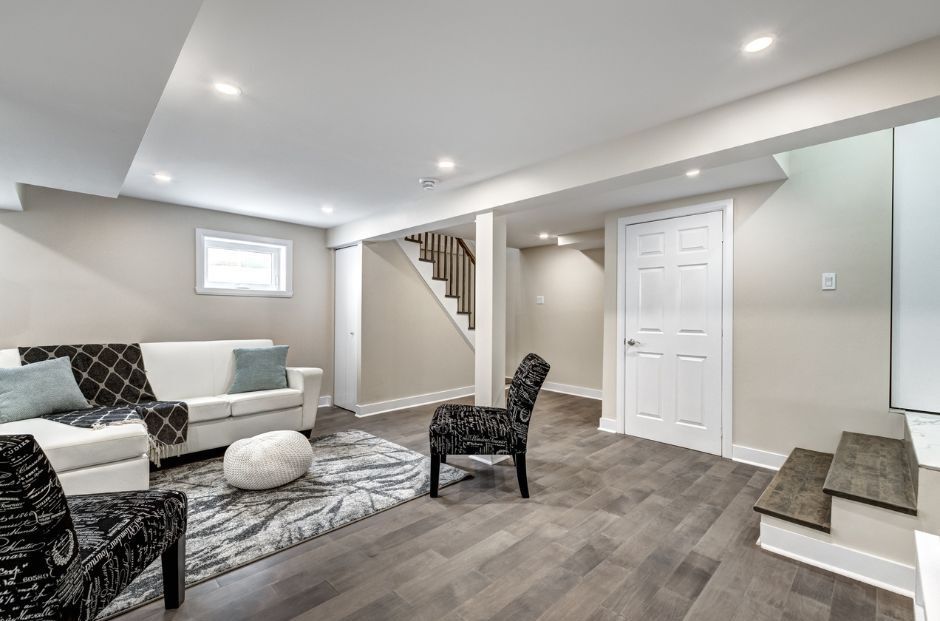Basement Finishing Services in Edmonton, AB

Many people complain about not having enough space in their homes but forget they have a lot of space available for them in their basement.
However, they ignore that space because they think it’s not worth it to invest in it or see it as a nuisance. Hiring a finished basement company is one of the best things you can do for your house.
Doing so helps you take more advantage of the space you have there and use it for anything you want. Nonetheless, you need to hire a decent basement finishing company if you want the process to work. We are Innovation Drywall of Edmonton, and we focus on finishing basements.
We work across Edmonton, Alberta, and you can call us whenever you want to get a free quote form for your basement finishing project. If you still have doubts about paying for basement renovations, dive into this page to know why investing in your basement can represent a profitable investment in the long run.
Is Finishing the Basement Worth it?
The short answer is yes, but even if we say so, you may ask yourself: “why is paying for basement remodeling or finishing basement walls a good thing for me?” Benefits come from investment purposes and optimization of the space you already have.
As for the former, finishing your basement increases the value of your house in case you want to sell it in the future.
One of the reasons not everyone wants to finish their basement is they think they are not going to live in that house for a long time. Fortunately, finishing your basement can get you more profits in the long run.
If you don’t want to sell your house any time soon, you can also benefit from basement finishing contractors. Do you want a gym? Have you always needed a sauna to relax after a day or hard work? Or do you just want a studio to relax from time to time? A basement finishing company can solve all those issues for you.
There are endless possibilities when it comes to finishing your basement since you can customize your drywall basement ceiling and design however you want.
Basements are also excellent when you live with children. They often don’t need a room for themselves when they are just babies, but you need to give them space for themselves when they grow up, so it’s best to have your basement available for that.
Aesthetic possibilities are also something you can explore when paying for drywall for basement walls. There are many design styles you can use for your residential properties, so you could use your basement to taste some designs and see if you can apply them to the whole house.
Finishing, Remodeling, and Renovating
Finishing basement walls is not the same as remodeling or renovating them. Those three processes are important and can help you in many ways, but you need to understand the difference between them before contacting your basement contractors.
Here is a brief overview of each of them:
Finishing
Finishing basements consists of making sure that area of your house is livable and available for people to go in. Therefore, unfinished basements are not ready for you to move in. You can see many unfinished basements lacking plumbing, lights, drywall, insulation, or being full of dust.
Remodeling
When you remodel a basement, the basement is already finished. Therefore, what people do is change the whole layout and design of the basement to adapt what you want for it. People often do this after a time to give basements a different use from the one they had before.
Renovating
Renovation projects also involve finished basements, but in this case, you don’t fully change the basement’s design. The purpose of renovating your basement is to update how it looks and add some features to it.
This process often requires people to repaint the whole area and install new flooring and ceiling.
Whether you are looking forward to putting up drywall in basement, remodeling, or renovating, IDOE is the one for the job. You can always trust Innovation Drywall of Edmonton, so call us or fill out our quote form whenever you are ready for a free consultation and estimate to finish basement.
How Much Does It Cost to Finish a Basement in Edmonton?
You may think of finishing your basement but keep yourself from doing it because of the fees it includes. Nonetheless, finishing a basement on a budget is not that difficult, and everything depends on the things you want for it.
Putting it simply, some factors can increase or decrease the cost to finish basement or basement remodeling.
Naturally, the project scope and the things you need to do directly increase the price of the process. If you only need to fix some things, you don’t have to pay that much for the job. However, things can get expensive if you need to renovate or finish all parts of your basement.
That also includes your basement size since some finishing and basement remodeling contractors charge you per square foot when giving you an estimate to finish your basement. Adding more sections to your basement also increases the cost of the whole job.
Material quality and equipment are also key factors when establishing a price for your basement finishing job. Using more durable materials represents an investment in the long run since you don’t have to think about replacing them in the future. Lower-quality materials can help you if you don’t have that many funds at the time.
How Much Does It Cost to Frame and Drywall a Basement?
Drywall increases the fees you need to pay when paying for basement refinishing, so ask the contractors you hire to tell you their fees for basement drywall. Most companies charge per linear foot when talking about drywall delivery to basement.
Finishing basement walls without drywall is less expensive, but that doesn’t mean you have to avoid drywalls.
Frequently Asked Questions
Renovating your home can be a stressful ordeal, especially if you have no prior drywalling knowledge or experience. Suppose you want to know more about the basement finishing process, the best time to apply a finish, and more. In that case, we encourage you to keep reading! We answer questions we often hear from homeowners in the section below.
Suppose your questions about basement finishing remain unanswered. In that case, we encourage you to contact us. We have a team of skilled experts that will happily help address your concerns or come out to your property to provide tailored solutions.
To get in touch with us, call us or complete the contact form and we’ll call you back!
Conclusion
Finishing a basement bathroom or paying for a remodeling project changes the vibe of your house and refreshes the whole environment.
However, you can only trust the best people you can find for the job. If you live in Edmonton, Alberta, Innovation Drywall Edmonton is ready to help you!
Call us as soon as you can to get a free quote for your project!

